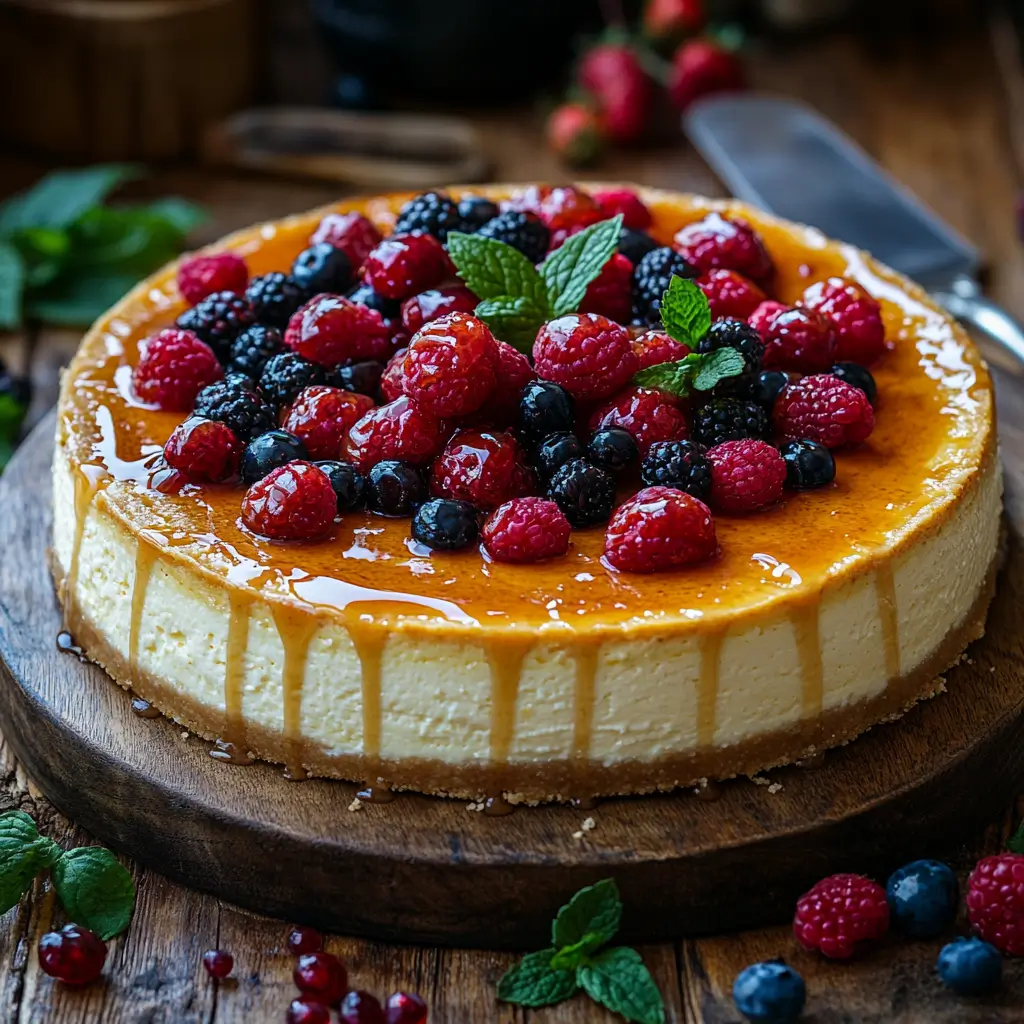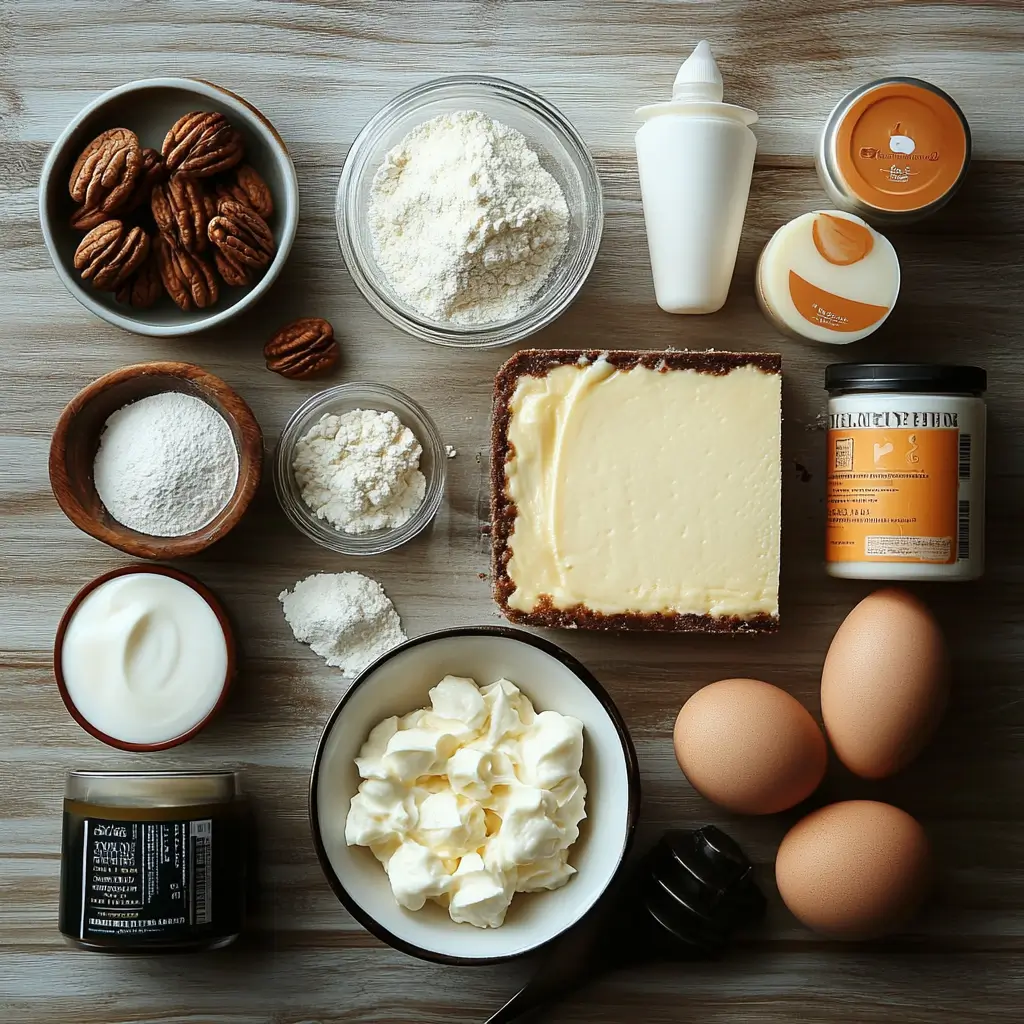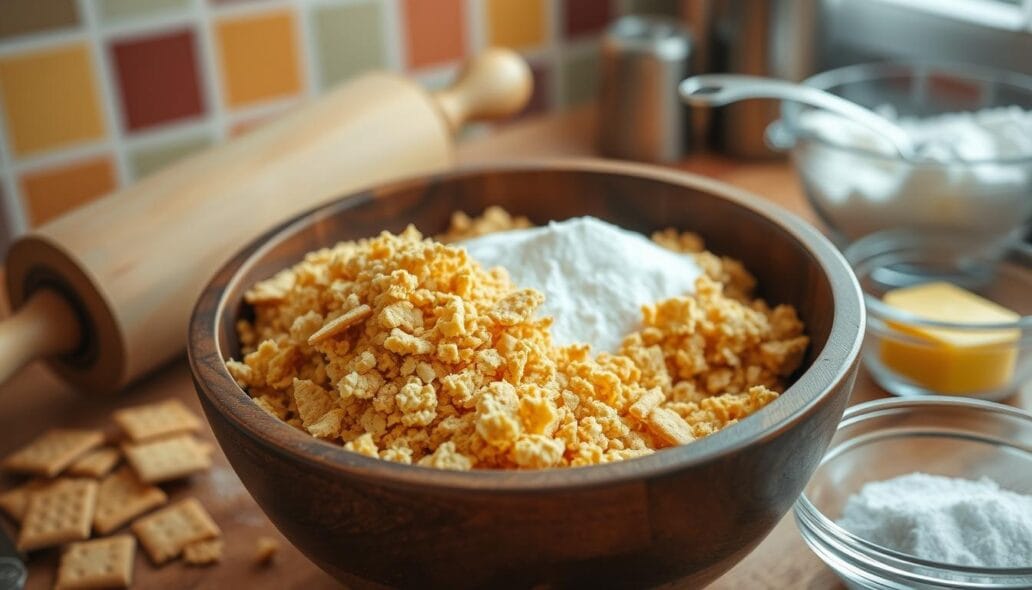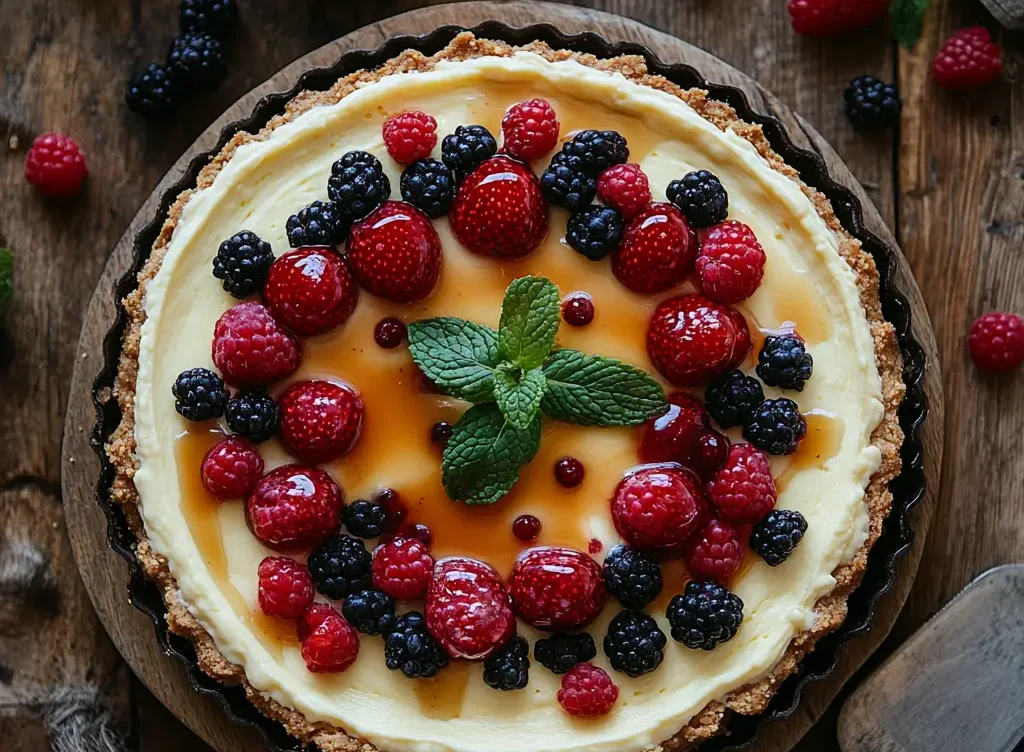Imagine a forkful of rich, velvety cheesecake that melts in your mouth. It’s accompanied by the subtle crunch of a perfectly baked graham cracker crust. This isn’t just a dessert; it’s a moment of pure bliss, a piece of culinary art that you created in your own kitchen.
The first time I successfully made a homemade cheesecake, I felt a rush of pride and joy. There’s something incredibly satisfying about mastering a dessert that many consider complex. With our detailed guide, you too can learn how to make cheesecake that will impress everyone around you.
My first attempt was far from perfect, with a cracked top and a soggy bottom, but I didn’t give up. After a few tries and some helpful tips, I nailed it. Now, it’s your turn. Dive into the creamy, dreamy world of homemade cheesecake.
This guide will walk you through everything from selecting the best ingredients to troubleshooting common issues. Whether you are making it for a special occasion or just treating yourself, mastering the best cheesecake recipe is a rewarding and delicious experience.
If you’ve ever wondered how to make cheesecake with that flawless, smooth texture, you’re in the right place. The secret lies in understanding the role of each ingredient and the proper techniques. Ready to embark on this delightful journey? Let’s get started.
For more delicious recipes to complement your cheesecake, check out this cheesy chicken pasta bake!
Table of Contents
Introduction to Homemade Cheesecake
Making a cheesecake at home might seem hard at first. But with our easy cheesecake recipe and some cheesecake tips, it’s fun and tasty. You can control the ingredients and add your own twist when you bake cheesecake at home.
Homemade cheesecake is creamy and full of flavor. It takes about 90 minutes to prepare, plus chill time. This dessert impresses everyone, with five-star reviews from 151 users.

To make the perfect cheesecake, start with the right ingredients. You’ll need graham cracker crumbs, full-fat cream cheese, sugar, sour cream, vanilla, and eggs. Cheesecake tips say to keep all ingredients at room temperature for a smooth mix.
With practice, you can master our easy cheesecake recipe. It’s perfect for any event. Whether you’re new or experienced, these basics will help you improve your cheesecake-making skills.
Ingredients You Will Need
Creating the perfect homemade cheesecake starts with the right ingredients. These ingredients are key to getting that creamy texture and rich flavor. Here’s what you’ll need for your cheesecake:

Full-Fat Cream Cheese: This is the base of any classic cheesecake. It should be room-temperature and high-quality. You’ll need five blocks, totaling 40 ounces.
Sour Cream: It adds creaminess and a slight tanginess. You’ll need about 16 ounces plus 2/3 cup more for this recipe.
Eggs and Egg Yolks: Use 5 large eggs and 3 more egg yolks at room temperature. They help bind the ingredients for the right consistency.
Additional Dairy: Add 1/2 cup (113 grams) of room-temperature heavy cream. It makes the cheesecake filling light and fluffy.
Granulated Sugar: You’ll need 1 and 1/2 cups (300 grams) for the filling and 1/3 cup (67 grams) for the crust.
Pure Vanilla Extract: Add 2 teaspoons of pure vanilla extract. It enhances the cheesecake’s flavor.
Unsalted Butter: Use 7 tablespoons (99 grams) of melted butter for the crust. It binds the graham cracker crumbs.
Graham Cracker Crumbs: You’ll need 2 cups (198 grams) of graham cracker crumbs. Bake them for 8 minutes at 350 degrees Fahrenheit for a golden crust.
“Choosing the right cream cheese is crucial,” advises seasoned chefs at The Cheesecake Factory with over five years of experience, emphasizing the use of the best cream cheese for cheesecake to ensure superior quality.
Want to try something different? You can use Greek yogurt instead of sour cream. Or add unique flavors like citrus zest or chocolate to your batter. By carefully choosing and preparing these ingredients, you can make an amazing dessert that everyone will love.
Preparing the Perfect Graham Cracker Crust
Making a crunchy crust is key to a great homemade cheesecake. First, get all your ingredients ready. You’ll need 1 ½ cups of finely crushed graham cracker crumbs, which is about 12 sheets. Mix these with 1/4 cup of sugar and 5 tablespoons of melted butter.
Combine the ingredients in a bowl until they’re well mixed. Then, press the mix into a 9-inch springform pan to make an even layer.

Next, pre-bake the crust at 350°F for about 10 minutes. This step is important for a crunchy crust that supports the cheesecake. The whole process takes about 15 minutes, making a solid base for your dessert.
Want to try something different? Use Oreo crumbs or a nut-based mix for your crust. These options can fit various diets or add a new twist to your cheesecake. Making a crunchy crust with these alternatives is easy; just adjust the amounts as needed.
For example, you can use 200g of digestive biscuit crumbs, 1/3 cup of sugar, and 6 tablespoons of melted butter. Pre-bake this crust at 350°F for 12-15 minutes to get it right.
People love homemade graham cracker crusts, giving them a 4.9 out of 5 star rating from 49 reviews. The preference for Nabisco Honey Maid graham crackers might be why.
The cheesecake pie crust has 1375 kcal, with 132g carbs, 10g protein, and 92g fat. It has 52g of saturated fat, 211mg of cholesterol, and 1534mg of sodium. But, enjoying it in moderation can make it guilt-free.
How to Make Cheesecake: Step by Step Instructions
Making cheesecake from scratch is a detailed process. It ensures every layer and ingredient is just right for the best taste and texture. Follow these steps to make a delicious homemade cheesecake.
- Step 1: Preparing the Ingredients
- Softening 2 pounds (900g) of cream cheese at room temperature for 2 hours.
- Letting full-fat sour cream sit at room temperature for 30 minutes to 1 hour.
- Using 4 large eggs, also at room temperature.
- Measuring 1 3/4 cups (230g) of graham cracker crumbs.
- Mixing 1 cup of granulated sugar and 2 cups (475ml) of sour cream for the filling.
- Step 2: Mixing the Batter
Use a mixer with a whisk attachment to mix ingredients smoothly. Add sugar to the softened cream cheese slowly. Then, add eggs one at a time to avoid too much air.
- Step 3: Baking Without a Water Bath
Pour the batter into a prepared crust in a 9- or 10-inch springform pan. Bake at 325°F for 1 hour and 30 minutes to 1 hour and 45 minutes. This method keeps the baking stable, but wrap the pan in heavy-duty foil to prevent leaks.
- Step 4: Cooling and Storing
Let the cheesecake cool in the oven for 1 hour with the door slightly open. Then, cool it at room temperature for another hour. Place it in the refrigerator to chill for at least 8 hours or overnight. This cooling prevents cracks and improves texture.
By following these steps, you’ll have a smooth and rewarding baking experience. You’ll end up with a delicious and beautiful homemade cheesecake.
Troubleshooting Common Issues
Getting the perfect cheesecake can be tricky. One big problem is when cracks appear on the surface. Preventing cracks in your cheesecake often means using a water bath. This keeps the baking area humid, which can cut down on cracking by up to 70%.
Another big issue is overbaking. A cheesecake should still jiggle a bit in the middle when it’s done. If it’s all wobbly, it’s not ready yet. The perfect temperature is between 150°F (66°C) and 155°F (68°C). Cheesecakes that are overbaked often crack and get dry.
Using cold ingredients can make the batter too airy. This can cause it to rise too much and then sink as it cools. Make sure all your ingredients are at room temperature before mixing. This helps avoid a too-soft texture and too much air in the batter.
Prebaking the crust at 375°F (190°C) for 8-10 minutes is key. It creates a seal before you add the batter. This helps prevent cracks in your cheesecake. If you skip this step, the crust might get soggy, ruining the texture.
Cooling the cheesecake right is also important. Let it cool in the oven for an hour after baking. This helps it cool down slowly, which prevents cracking. Then, cool it in the fridge overnight to set it properly.
Even with the best care, cracks can still happen. A sour cream topping can cover up these cracks and make the cheesecake look better. Also, make sure the springform pan is well-greased. This can cut down on sticking by about 40%, making it easier to remove the cheesecake without cracking.
Preventing cracks in your cheesecake takes some effort and following the right steps. But the end result—a smooth, perfectly textured cheesecake—is worth it.
The Role of Room Temperature Ingredients
When baking the perfect cheesecake, knowing why room temperature matters is key. The creaminess of your batter depends on the ingredients’ temperature. Room temperature, between 70–75°F (21–24°C), makes the batter smooth and creamy.
Butter, eggs, and dairy products like cream cheese and heavy cream need to be at room temperature. This ensures even mixing and avoids lumps. Here’s why room temperature matters more than you might think:
- Better Creaming: Room temperature ingredients blend better. For example, creaming softened butter and sugar makes a lighter mix. Cold butter can make the mix dense.
- Enhanced Emulsification: Eggs and dairy at room temperature trap air bubbles well. This is key for meringues and chiffon cakes. Cold ingredients can break the emulsification, making the batter grainy.
- Consistency: Cold ingredients mixed with room temperature ones can make the batter seize up. This affects the cheesecake’s final texture.
Getting your ingredients to the right temperature is easy. Here are some tips for baking a cheesecake:
- Butter: Heat in the microwave for 8 seconds on one side, then 7 seconds on the other.
- Eggs: Leave them out for 1 to 2 hours or warm them in a bowl of warm water for 10-15 minutes.
- Cream Cheese: Sit it out for 1 to 2 hours. For quicker warming, cut it into smaller pieces.
Understanding the importance of room temperature is crucial for any serious baker. This small detail can greatly improve your cheesecake’s texture and quality. By following these simple steps, you can make a creamy, smooth, and delicious cheesecake every time.
Expert Tips for a Creamy Texture
To make a smooth cheesecake, focus on mixing and cooling. You’ll need 2 packages of cream cheese (500g), 2 large eggs at room temperature, and ⅓ cup of full-fat sour cream. This mix is the key to a great cheesecake.
When mixing the batter, avoid over-mixing. Over-mixing can introduce air bubbles, which can cause cracks. Mix at a low speed and beat the eggs lightly. Add eggs one at a time, making sure each is fully mixed before adding the next.
A water bath is also crucial. It ensures even baking and prevents drying or cracking. Place your springform pan in a larger pan filled with hot water. But, be careful to avoid leakage to keep the crust dry.
Cooling the cheesecake slowly is also key. After baking for 40 minutes, let it cool in the oven for 30 minutes with the door closed. This prevents sudden temperature changes that can cause cracks or a lumpy texture. Let it cool at room temperature before refrigerating for at least 4 hours.
These tips are vital for a creamy cheesecake. By avoiding over-mixing and cooling slowly, you’ll create a silky and delicious dessert.
Decorating and Serving Your Cheesecake
Decorating your cheesecake can be as fun as eating it. A well-decorated cheesecake looks great and tastes even better. Here are some ideas to make your cheesecake stand out at any party.
Choosing the right *optional toppings and enhancements* is key. Fresh fruits like strawberries or blueberries add color and a bit of tartness. A drizzle of caramel or chocolate ganache adds a rich touch. Whipped cream rosettes around the edge look classic and elegant.
For a fancy look, how you plate matters. Use a warm knife for clean cuts. This small detail makes a big difference in presentation.
Adding garnishes can take your plating to the next level. A few mint leaves, powdered sugar, or lemon zest can make a big impact. Remember, the first bite is with the eyes, so decorate with care.
With these *optional toppings and enhancements*, your cheesecake will impress everyone. By focusing on looks and taste, you’ll make your cheesecake the star of any event.
Storing and Freezing Cheesecake
Proper storage keeps your cheesecake fresh and tasty. Follow the best practices for refrigeration to keep it delicious. Here are the key steps for storing cheesecake:
- Chill the cheesecake in the fridge overnight to set fully.
- Wrap it in two layers of plastic wrap and a layer of heavy-duty foil to seal it.
- Keep it in the fridge for up to 7 days.
Freezing your cheesecake is another way to keep it fresh. Here’s how to freeze it:
- Let the cheesecake cool at room temperature for up to 2 hours.
- Wrap it in two layers of plastic wrap and a layer of heavy-duty foil.
- Freeze it as soon as it’s cold. It’s best to eat it within six weeks.
When you’re ready to thaw your frozen cheesecake, do it safely:
- Thaw it in the fridge overnight (about 12 hours for a whole cheesecake).
- Don’t thaw it at room temperature to avoid bacterial growth.
- Thawing individual slices takes about two to four hours in the fridge.
Remember, individual slices thaw faster than a whole cheesecake. Freezing individual slices is convenient. It makes thawing and eating quicker.
Following the best practices for refrigeration and freezing is key. It ensures your cheesecake stays delicious and fresh. Whether you’re storing it short-term or freezing it for later, these tips will help.
Exploring Cheesecake Variations
Cheesecake variations offer something for everyone. They’re perfect for quick desserts or new flavors. Start with a no-bake cheesecake recipe for easy prep.
Try a Fruit Swirl Cheesecake for a fruity twist. Use seasonal fruits like blueberry, raspberry, or mango. Swirl the puree into the mix for a stunning and tasty dessert. Here’s a simple blueberry swirl idea:
- 2 cups of blueberries
- 1/4 cup of sugar
- 1 teaspoon of lemon zest
- 1½ pounds of cream cheese
- 1 cup of sugar in the cheesecake batter
- 1/2 cup of crème fraiche or sour cream
- 4 eggs
Chocolate lovers will enjoy chocolate cheesecake variations. Add ganache, praline, or peanut butter for a rich taste. This makes the cheesecake more decadent and attractive. Try this no-bake cheesecake recipe with chocolate swirls for a quick treat.
There are many other cheesecake options. Cheesecake bars are great for groups, and Japanese Cotton Soft Cheesecake is light and fluffy. Cheesecake recipes are endless, offering new surprises for your taste buds and guests.
Don’t forget to try different toppings. Popular choices include:
- Fruit toppings
- Poured ganache
- Piped icing
- Meringue
- Candied nuts
- Sweet sauces (chocolate or caramel)
Whether baking or making a no-bake cheesecake recipe, cheesecake is versatile. From fruit swirls to chocolate, each twist is unique. So, experiment and make your own cheesecake masterpiece.
Conclusion
Making the perfect homemade cheesecake is both an art and a science. It’s about mixing precise measurements with a dash of creativity. Each step, from picking ingredients to baking, helps create that creamy texture and delicious taste. It’s not just about taste; it’s also about how it looks and how you serve it.
You start with 2 pounds of cream cheese, 1 1/3 cups of sugar, and 4 eggs. These ingredients form a rich base. Adding 2 teaspoons of vanilla extract and 2/3 cup of sour cream and heavy whipping cream each adds to the flavor and creaminess. The crust, made from 1 3/4 cups of graham cracker crumbs, 2 tablespoons of sugar, and 4 tablespoons of melted butter, is baked at 350°F for 10 minutes. The filling, baked at 325°F for 1.5 hours in a water bath, should be perfect and slightly jiggly at the center.
After baking, top your cheesecake with a mix of 2 cups sour cream, 1/3 cup powdered sugar, and 1 teaspoon vanilla. You can also add a fresh raspberry sauce made with ½ cup sugar and water. Cheesecakes taste best when made 1-2 days in advance. This allows the flavors to blend perfectly. By following these steps, you’ll make an easy and delicious cheesecake that’s as good as those from New York City’s top spots.
For more tasty recipes and cooking tips, check out this creamy chicken noodle casserole. It’s a great match for your homemade cheesecake. Happy baking!
FAQ
What ingredients are essential for making a classic cheesecake recipe?
For a classic cheesecake, you need full-fat cream cheese, sour cream, eggs, and sugar. These ingredients make it creamy and rich.
How do I make a graham cracker crust for my cheesecake?
Mix graham cracker crumbs, sugar, and melted butter until combined. Press it into your pan and bake briefly. This sets the stage for your creamy filling.
What is the best cream cheese to use for cheesecake?
Use high-quality full-fat cream cheese for the best cheesecake. It gives a rich texture and flavor.
Can I use a no-bake cheesecake recipe instead of baking it?
Yes, no-bake cheesecakes are a great option. Prepare the crust and filling, then chill until set.
How can I prevent cracks in my cheesecake?
To avoid cracks, bake slowly and cool gradually. Using a water bath helps too. Even temperature is key.
Why is it important to use room temperature ingredients when making cheesecake?
Room temperature ingredients blend better, avoiding lumps. This ensures a smooth texture, crucial for success.
What are some tips for achieving a creamy cheesecake texture?
Mix at low speed, add eggs one at a time, and cool slowly. These steps prevent air and sudden temperature changes, for a creamy texture.
What are some popular toppings for decorating a cheesecake?
Top with fresh fruits, whipped cream, or chocolate ganache. These enhance flavor and appearance, making it more appealing.
How should I store my cheesecake to keep it fresh?
Store in the fridge, covered with plastic wrap to avoid odors. Freezing is great for longer storage. Proper wrapping is key for flavor and texture.
What are some variations of traditional cheesecake I can try?
Try no-bake, fruit swirl, or chocolate cheesecakes. Each offers a unique twist, catering to different tastes.
